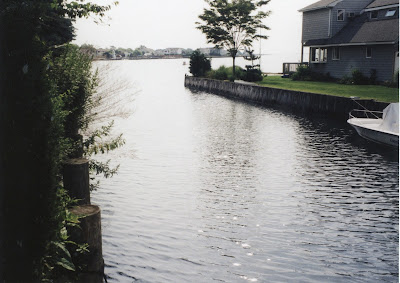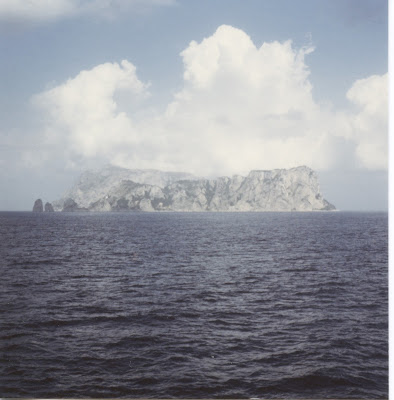Situated on Unqua Point in the Nassau
Shores neighborhood of Massapequa, Long Island, the yacht club provided
berthing for a variety of small recreational sailboats and motorboats that
spent their summers plying the protected and shallow waters of the Great South
Bay. Only one of these vessels could
properly be called a yacht, though. This
was a broad-beamed, gaff-rigged, bowsprited New Englander, conspicuous for her
size and design, and somewhat out of her element on the South Shore of Long
Island. We saw her frequently at the
dock, but seldom underway. At the time,
I hardly gave it a thought, but my parents wondered about this boat as we
sailed our diminutive Justine up and
down the channel between Unqua Point and Karras Creek.
This channel was the thoroughfare that
skirted the mud flats east of Massapequa and south of Amityville and led to
comparatively deeper and more open water.
From Karras Creek, where my parents kept the Justine, it was a fairly short and easy sail to the open bay, if
the wind was right. When the wind didn’t
work, we paddled. Eventually, when my
father got tired of paddling, he invested in a small outboard motor. I was a small child then. My father did not appreciate my powers of
observation when one day I remarked that while the new motor broke down
routinely, the old paddles always worked just fine.
We sailed on the Great South Bay from
Karras Creek in the mid-1960s. In the
1970s, my parents traded in their sailboat for a slightly larger Justine, and they berthed the new boat
first in Lindenhurst and later in Babylon.
Aboard these vessels in my formative years, we sailed the bay from
Massapequa to Heckscher State Park. In
my teen years, I decided that the bay was too small for me and yearned to sail
on the open Atlantic. Eventually I did
this, but aboard vessels somewhat larger and more durable than the
twenty-feet-long Justine. In all my transoceanic travels, though, the
memories of my childhood voyages remained with me, and I have returned to the
Great South Bay many times.
On one such occasion, two of my sons
accompanied me to Massapequa, and we visited both Karras Creek and Unqua
Point. This outing took place on
Saturday, June 2, 2005. Not
surprisingly, forty years after my initial voyages aboard the Justine, many things had changed. Karras Creek, Unqua Point, and the Great South
Bay were of course all still there, but the neighborhood had been
revamped. Karras Creek abutted the
Riviera, a waterfront party house used for weddings and other special
occasions. Back in the day, this was a
large but humble and down-to-earth affair.
It has since been gentrified into a five-star, world-class venue
complete with brick driveways, Belgian block curbing, and lavish
landscaping. Down the street at Unqua Point,
the yacht club was completely gone. In
its place stood the new Nassau Shores Bayfront Park, a publicly owned facility
with playground equipment, expansive lawns, and benches facing the water. In its simplicity of design and with its expansive
views of the bay, this new park was quite impressive.
My sons were not very impressed, though,
either with the new facilities or the family’s connection with the old
facilities. I looked at it all
philosophically. In four decades, places
and people do change. Just as the old waterfront neighborhood in Massapequa had
undergone a metamorphosis, so had I.
Indulging my sons’ patience for a while, then, I gazed at the Great
South Bay from the new park and found plenty of food for thought.
This was the place where my lifelong love
of the sea had started. I was six years
old when my parents bought the Justine. The bay was different then. The water was cleaner and there was less
traffic on it. The mud and sand bottom
teemed with clams ripe for the picking. People were friendlier. When boats sailed past each other, their
crews waved and called out greetings. If
someone’s boat got in trouble, folks on other boats would come by and help. It was all very neighborly, a microcosm of the
universal brotherhood of the sea.
Since that time so long ago, many tides
have come and gone, and the salt water that filled the bay then has since
travelled around the world many times. The
same seawater that carried the tiny Justine
on her intracoastal cruises also carried the great cargo ships of my subsequent
career on their more ambitious voyages.
It was a big leap from the Justine
to the Rigel and the Waccamaw and the Comet, but everything big originates as something small, just as
the oak tree starts life as an acorn.
Holding the Justine on a
steady course as the wind filled her sails later became bringing the Waccamaw alongside an aircraft carrier
in the Mediterranean for underway replenishment and maneuvering the Comet through the fishing fleets in the
Sea of Japan. Studying the chart of the
Great South Bay and navigating by landmarks aboard the Justine became navigating by the sun, moon, and stars first on the New Jersey Sun and then aboard a host of
subsequent ships. And recreational sailing
under the tutelage of kindly parents became important employment, often with
roughneck crewmen and demanding if basically good-natured Captains. The happy innocence of childhood was thus
replaced by the serious responsibilities of an often difficult profession.
Indulging my sons’ patience just a little
longer, I thought of what I had gained from going to sea. The sea gave me tangible experiences and also
taught me abstract qualities that in turn produced tangible results. The sea taught me motivation, ambition,
perseverance, and discipline. It taught
me to set priorities and distinguish between genuine needs and mere wants. It
taught me to do what must be done, to consider the next step, and to anticipate
the likely consequences of decisions and actions. It taught me to gauge other people and
determine what qualities they possessed.
All this and more that I learned from the sea has accompanied me through
life since. The sea was one of the three
things that shaped my character and made me the person that I am. The other two influences were church and family,
and while the three worked in harmony, I came of age at sea.
Like so many things in life, the yacht
club had its moment in time and then passed into oblivion. But the small inland sea beside which it
stood remains, as does the larger sea that encircles the Earth. The sea will continue long after I am gone,
and it will teach future generations of young merchant seamen as it did
me. In some ways the sea was the best
teacher I ever had. And to think that it
all started here, on the sheltered and shallow water of the Great South Bay! This was indeed the cradle of my craft, and
for that I will always be profoundly thankful.
Now let’s look at some photographs of the
old waterfront neighborhood:
 |
| This is Karras Creek in Massapequa, Long Island, in the summer of 1967, in one of my very early attempts at photography. The sailboat in the left foreground is the Justine. |
 |
| A much better view of Karras Creek and the Justine in the summer of 1967 taken by my father. |
 |
| Yours truly at the helm of the Justine, underway on the Great South Bay in 1967. |
 |
| Returning after many years and many voyages, we see Karras Creek on Saturday, June 2, 2005. |
 |
| The entrance to the new park on the site of the old yacht club on the same day in 2005. Steven and Michael pose by the sign. |













